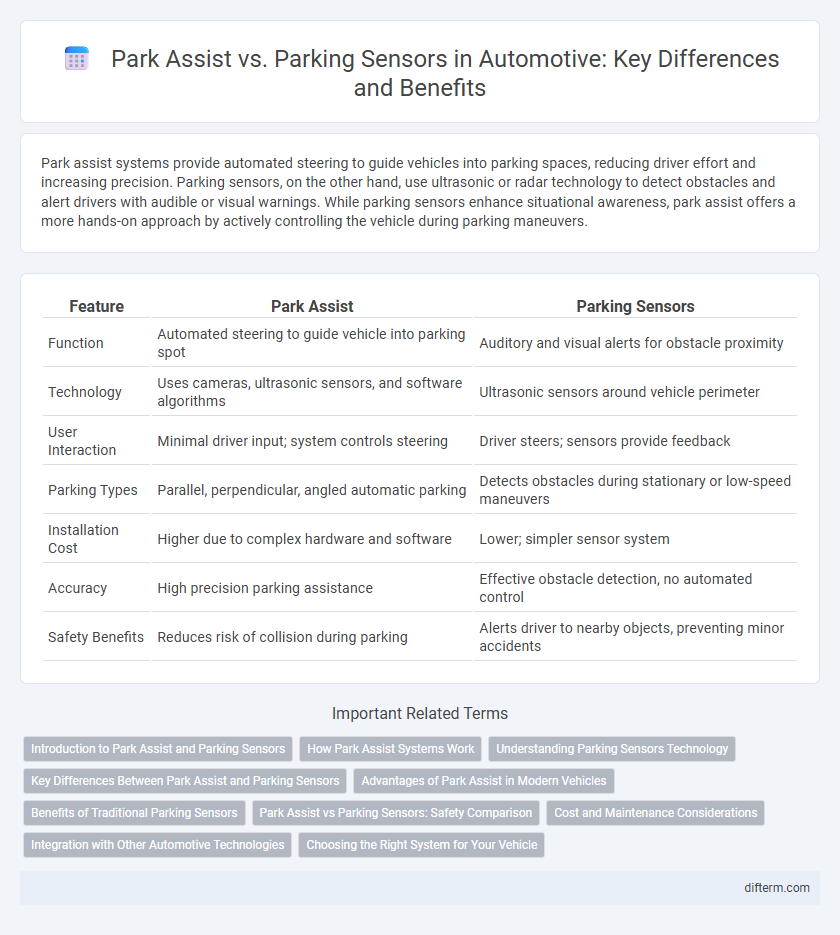Park assist systems provide automated steering to guide vehicles into parking spaces, reducing driver effort and increasing precision. Parking sensors, on the other hand, use ultrasonic or radar technology to detect obstacles and alert drivers with audible or visual warnings. While parking sensors enhance situational awareness, park assist offers a more hands-on approach by actively controlling the vehicle during parking maneuvers.
Table of Comparison
| Feature | Park Assist | Parking Sensors |
|---|---|---|
| Function | Automated steering to guide vehicle into parking spot | Auditory and visual alerts for obstacle proximity |
| Technology | Uses cameras, ultrasonic sensors, and software algorithms | Ultrasonic sensors around vehicle perimeter |
| User Interaction | Minimal driver input; system controls steering | Driver steers; sensors provide feedback |
| Parking Types | Parallel, perpendicular, angled automatic parking | Detects obstacles during stationary or low-speed maneuvers |
| Installation Cost | Higher due to complex hardware and software | Lower; simpler sensor system |
| Accuracy | High precision parking assistance | Effective obstacle detection, no automated control |
| Safety Benefits | Reduces risk of collision during parking | Alerts driver to nearby objects, preventing minor accidents |
Introduction to Park Assist and Parking Sensors
Park assist systems combine sensors and automated steering to guide vehicles into parking spaces, reducing driver effort and enhancing safety. Parking sensors use ultrasonic or electromagnetic technology to detect obstacles around the vehicle, providing audible or visual alerts to prevent collisions. Together, these technologies improve precision and confidence during parking maneuvers in modern automotive design.
How Park Assist Systems Work
Park assist systems use ultrasonic sensors and cameras to detect surrounding obstacles, creating a detailed map of available parking space. These systems process real-time data through advanced algorithms to guide the vehicle's steering, acceleration, and braking, enabling precise automated parking maneuvers. Unlike basic parking sensors that only alert drivers about nearby objects, park assist integrates sensor input with vehicle control for hands-free parking assistance.
Understanding Parking Sensors Technology
Parking sensors use ultrasonic or electromagnetic technology to detect obstacles around a vehicle, providing drivers with audio or visual alerts to prevent collisions during parking. Park assist systems build on this technology by automating steering inputs to guide the vehicle into parking spaces more precisely. Understanding the sensor range, detection accuracy, and system integration helps drivers choose between basic parking sensors and advanced park assist features for enhanced parking safety.
Key Differences Between Park Assist and Parking Sensors
Park assist systems provide automated steering to guide a vehicle into a parking space, using cameras and sensors to control the maneuver, while parking sensors primarily offer audible alerts to indicate the proximity of obstacles. Park assist often includes features like parallel and perpendicular parking capabilities, enhancing driver convenience, whereas parking sensors focus on collision avoidance during low-speed maneuvers. The key difference lies in park assist's active steering control versus parking sensors' passive obstacle detection.
Advantages of Park Assist in Modern Vehicles
Park Assist in modern vehicles offers precise automated steering control, reducing driver error during complex parking maneuvers and enhancing overall safety. Unlike basic parking sensors that only detect obstacles, Park Assist integrates advanced cameras and radar systems to provide real-time guidance and seamless parking in tight spaces. This technology significantly improves convenience and reduces the risk of minor collisions, making it a valuable feature for urban driving environments.
Benefits of Traditional Parking Sensors
Traditional parking sensors provide reliable proximity detection through ultrasonic waves, alerting drivers to obstacles in real-time and reducing the risk of collisions. These sensors are cost-effective and require minimal installation effort, making them accessible for a wide range of vehicles. Their simplicity and durability ensure consistent performance in various weather conditions, enhancing overall parking safety.
Park Assist vs Parking Sensors: Safety Comparison
Park Assist systems provide automated steering control, enabling precise and safe maneuvering into parking spaces, reducing driver error and potential collisions. Parking sensors offer proximity alerts through audio or visual signals to detect obstacles, but rely on driver response for maneuvering. Park Assist enhances overall parking safety by combining sensor data with intelligent steering intervention, while parking sensors primarily serve as alert mechanisms to prevent accidents.
Cost and Maintenance Considerations
Park assist systems generally involve higher upfront costs and more complex maintenance due to advanced sensors and integrated software requiring specialized diagnostics. Parking sensors, typically ultrasonic or radar-based, offer a more affordable initial investment with lower maintenance expenses, often limited to occasional cleaning or sensor replacement. Choosing between the two depends on budget constraints and long-term maintenance capabilities, with parking sensors being cost-effective for basic assistance and park assist providing enhanced functionality at increased cost.
Integration with Other Automotive Technologies
Park assist systems integrate seamlessly with advanced driver assistance technologies such as adaptive cruise control, lane-keeping assist, and 360-degree cameras, creating a cohesive and automated parking experience. Parking sensors primarily serve as standalone devices, providing proximity alerts without deep integration into the vehicle's broader safety or navigation systems. This integration enhances overall vehicle intelligence, enabling smoother, safer parking maneuvers while reducing driver workload.
Choosing the Right System for Your Vehicle
When choosing the right system for your vehicle, park assist offers advanced guidance through automated steering and camera integration, ideal for drivers seeking ease in tight spaces. Parking sensors provide essential proximity alerts using ultrasonic or electromagnetic sensors, enhancing safety without complex automation. Consider vehicle type, driving habits, and budget to select a system that balances convenience, technology, and cost-effectiveness.
park assist vs parking sensors Infographic

 difterm.com
difterm.com